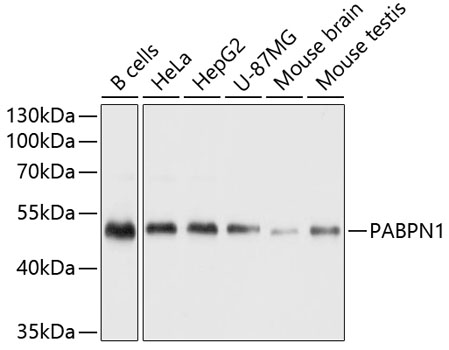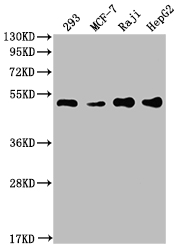PABPN1 antibody
GTX101490
ApplicationsImmunoFluorescence, Western Blot, ImmunoCytoChemistry, ImmunoHistoChemistry, ImmunoHistoChemistry Frozen, ImmunoHistoChemistry Paraffin
Product group Antibodies
TargetPABPN1
Overview
- SupplierGeneTex
- Product NamePABPN1 antibody
- Delivery Days Customer9
- Application Supplier NoteWB: 1:500-1:3000. ICC/IF: 1:100-1:1000. IHC-P: 1:100-1:1000. *Optimal dilutions/concentrations should be determined by the researcher.Not tested in other applications.
- ApplicationsImmunoFluorescence, Western Blot, ImmunoCytoChemistry, ImmunoHistoChemistry, ImmunoHistoChemistry Frozen, ImmunoHistoChemistry Paraffin
- CertificationResearch Use Only
- ClonalityPolyclonal
- Concentration0.49 mg/ml
- ConjugateUnconjugated
- Gene ID8106
- Target namePABPN1
- Target descriptionpoly(A) binding protein nuclear 1
- Target synonymsOPMD, PAB2, PABII, PABP-2, PABP2, polyadenylate-binding protein 2, poly(A) binding protein 2, poly(A) binding protein II
- HostRabbit
- IsotypeIgG
- Protein IDQ86U42
- Protein NamePolyadenylate-binding protein 2
- Scientific DescriptionThis gene encodes an abundant nuclear protein that binds with high affinity to nascent poly(A) tails. The protein is required for progressive and efficient polymerization of poly(A) tails on the 3 ends of eukaryotic genes and controls the size of the poly(A) tail to about 250 nt. At steady-state, this protein is localized in the nucleus whereas a different poly(A) binding protein is localized in the cytoplasm. An expansion of the trinucleotide (GCG) repeat from normal 6 to 8-13 at the 5 end of the coding region of this gene leads to autosomal dominant oculopharyngeal muscular dystrophy (OPMD) disease. Multiple splice variants have been described but their full-length nature is not known. One splice variant includes introns 1 and 6 but no protein is formed. [provided by RefSeq]
- Storage Instruction-20°C or -80°C,2°C to 8°C
- UNSPSC12352203






